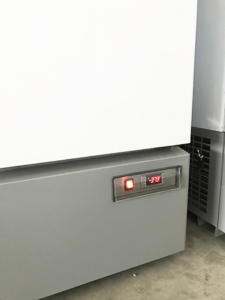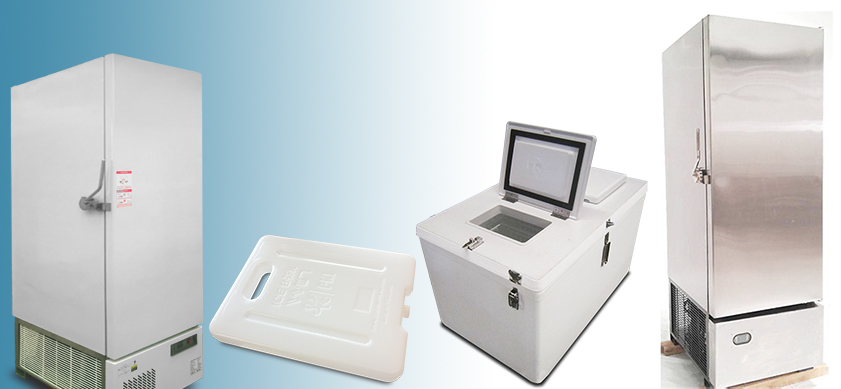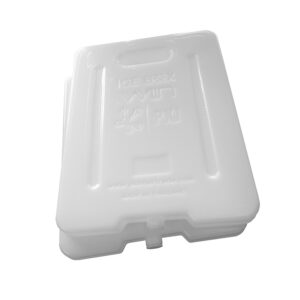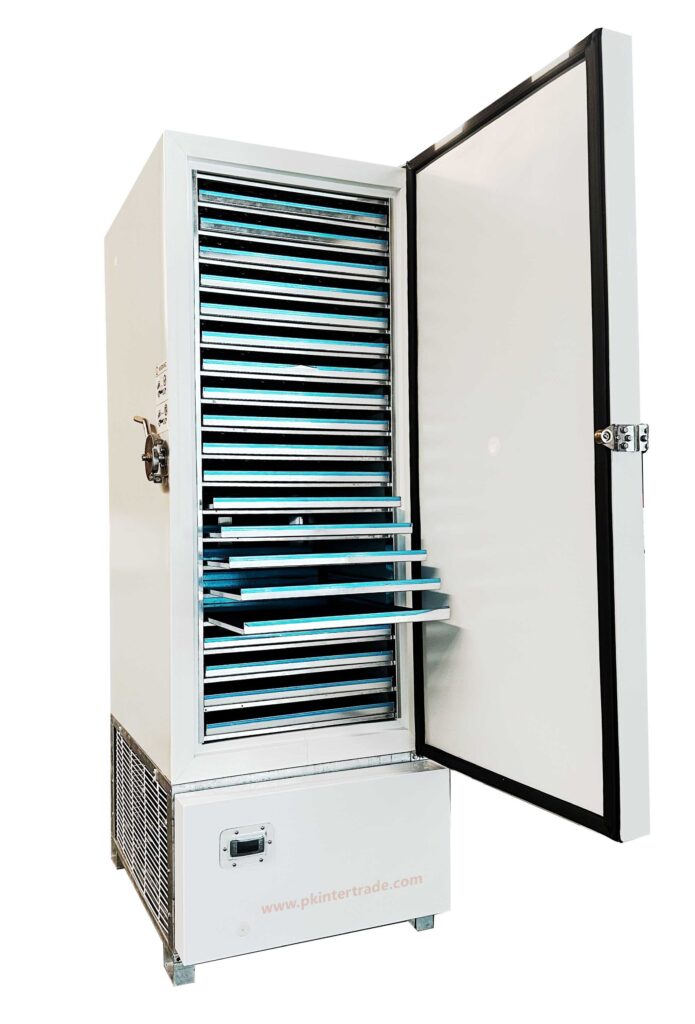Plate Freezer – All Important Information about Eutectic System
A Plate Freezer (Eutectic Deep Freezer, Contact Plate) is a type of industrial freezer commonly used in food processing and other industries to rapidly freeze products. It works by using metal plates that come into direct contact with the product to freeze it. The Cold plates are typically made of materials with excellent thermal conductivity, like aluminum or stainless steel.
Key Features of Plate Freezers:
- Design: Plate Freezer (Eutectic Deep Freezer, Contact Plate) consists of large metal plates that are arranged in a stack. The product to be frozen is placed between the plates, and the plates are pressed together to provide rapid freezing.

- Principle of Operation: The product is placed between the cold plates, which are cooled by a refrigerant circulating inside the plate system. The cold plates absorb heat from the product, causing the product’s temperature to drop quickly.
- Types of Products: Plate Freezer (Eutectic Deep Freezer, Contact Plate) are suitable for a wide range of food products, such as fish, meat, poultry, vegetables, and bakery items. They’re especially useful for freezing bulk products, such as fillets or pre-packaged goods.
- Advantages:
- Rapid Freezing: Plate Freezer (Eutectic Deep Freezer, Contact Plate) provides a high rate of heat transfer, which helps to quickly freeze products while preserving their quality.
- Energy Efficiency: The close contact between the product and the plates leads to efficient heat transfer and often lower energy consumption compared to other types of freezing methods.
- Uniform Freezing: Because the product is compressed between the cold plates, the freezing process is uniform and ensures consistent quality.
- Applications: Eutectic Systems (Eutectic Deep Freezer, Contact Plate) are used in industries like:
- Food processing: For freezing seafood, meats, and ready-to-eat meals.
- Warehousing: To store frozen food products.
- Pharmaceuticals: For the freezing of biological materials.
Plate Freezer (Eutectic Deep Freezer, Contact Plate) can be designed for various capacities, from small units suitable for smaller operations to large-scale freezers for industrial applications.
Detailed Explanation of Plate Freezers
 A Plate Freezer (Eutectic Deep Freezer, Contact Plate) is a type of rapid freezing equipment widely used in industrial food processing. It is designed to quickly freeze products by utilizing direct contact with cold, metal plates. This process helps maintain the product’s quality, texture, and nutritional value by minimizing ice crystal formation. Below is an in-depth look at how plate its work, their components, operational principles, and advantages.
A Plate Freezer (Eutectic Deep Freezer, Contact Plate) is a type of rapid freezing equipment widely used in industrial food processing. It is designed to quickly freeze products by utilizing direct contact with cold, metal plates. This process helps maintain the product’s quality, texture, and nutritional value by minimizing ice crystal formation. Below is an in-depth look at how plate its work, their components, operational principles, and advantages.
Components of Plate Freezers:
- Freezing Plates:
- The core component of a Plate Freezer (Eutectic Deep Freezer, Contact) is the stack of freezing plates. These plates are typically made of materials with high thermal conductivity such as stainless steel or aluminum.
- The plates are cooled by refrigerant (commonly ammonia or freon), which circulates through channels inside the plates.
- Refrigeration System:
- The refrigeration system is designed to lower the temperature of the plates. The refrigerant, after being compressed, passes through the plate channels, absorbing heat from the plates and reducing their temperature.
- The temperature of the plates can typically be as low as -30°C to -40°C (-22°F to -40°F) depending on the type of product being frozen.
- Product Handling Mechanism:
- The product is placed between the stacked plates. This can be done manually, through a conveyor system, or with automated loading/unloading mechanisms.
- There may be specialized racks or trays for products like fish fillets, meat cuts, or packaged goods that allow for efficient airflow and uniform freezing.

- Hydraulic or Pneumatic Press:
- Many Plate Freezers (Eutectic Deep Freezer, Contact Plate) feature a pressing mechanism to apply pressure between the plates. This ensures that the product is in full contact with the plates for uniform freezing.
- In some systems, a hydraulic press or air compressor can be used to ensure the plates come together with enough force to tightly compress the product, enhancing heat transfer.
- Control Panel:
- The Eutectic System (Eutectic Deep Freezer, Contact Plate) includes a control panel that allows operators to monitor and adjust the freezing cycle, including temperature settings and the pressure applied by the plates.
- Modern Plate Freezer (Eutectic Deep Freezer, Contact Plate) often have automated control systems for precise temperature regulation, reducing the need for manual intervention.
How Plate Freezers Work:
- Product Loading:
- The product, whether it’s raw meat, fish fillets, vegetables, or pre-packaged goods, is loaded into the freezer between the metal plates.
- The products are arranged in such a way that they have direct contact with the cooling plates, ensuring maximum heat exchange.
- Freezing Process:
- The refrigeration system chills the plates, and when the plates are at the desired low temperature (typically -30°C to -40°C), the product is pressed between them.
- The cold plates rapidly absorb heat from the product, reducing its temperature quickly.
- The rapid freezing prevents large ice crystals from forming, which is crucial for maintaining the quality, texture, and taste of the product. For example, in seafood, slow freezing can cause the formation of large ice crystals that damage cellular structures, leading to loss of moisture upon thawing.
- Thermal Transfer:
- Heat transfer occurs through direct conduction between the cold plates and the product. Since metal is a highly conductive material, heat flows quickly from the product to the plates, speeding up the freezing process.
- The pressing action ensures uniform freezing and minimizes the potential for air gaps, which could lead to uneven freezing.
- Freezing Duration:
- The freezing time depends on the type of product, the thickness of the product, and the freezer design. In general, freezing can take anywhere from 30 minutes to several hours.
- The Plate Freezer (Eutectic Deep Freezer, Contact Plate) operates in cycles: once one set of products is frozen, the plates can be released and prepared for another load.
- Unloading:
- After the products are frozen to the desired temperature, the plates are separated, and the frozen products are removed. The products can then be packaged and stored or transported to other parts of the production process.

Types of Plate Freezers:
- Horizontal Plate Freezers:
- In this configuration, the plates are arranged horizontally, and the products are placed in between them.
- They are particularly useful for freezing bulk products, like fish, where the product is flat and can be placed between the plates in large quantities.
- Vertical Plate Freezers:
- The plates are stacked vertically, and the product is loaded from the top or side.
- These systems are more space-efficient and are typically used for individual portions or pre-packaged goods. Vertical Plate Freezer (Eutectic Deep Freezer, Contact Plate) are also easier to integrate into existing lines with conveyors.
- Modular Plate Freezers:
- These Eutectic Systems (Eutectic Deep Freezer, Contact Plate) consist of independent modular units that can be stacked or combined to meet the freezing capacity needs.
- Modular systems are scalable and allow for flexibility in adapting to the changing needs of a business.
Advantages of Plate Freezers:
- Rapid Freezing:
- The direct contact between the product and the plates allows for fast heat transfer, which is critical for minimizing the loss of quality during freezing. Rapid freezing results in smaller ice crystals, which preserve the texture and flavor of the product.
- This is particularly important for high-value or delicate products like seafood and meat, where texture and moisture retention are vital.
- Energy Efficiency:
- Plate Freezers (Eutectic Deep Freezer, Contact Plate) are highly energy-efficient compared to other freezing technologies like air blast freezers. The compact design and direct heat exchange reduce energy consumption.
- By maximizing heat transfer, the refrigeration system doesn’t need to work as hard, leading to lower operating costs.
- Uniform Freezing:
- The product is pressed between metal plates, ensuring that the freezing process is uniform across all surfaces. This prevents the formation of temperature gradients that can result in inconsistent freezing.
- For bulk products like fish fillets, this ensures that all parts of the product freeze at the same rate, avoiding quality issues related to uneven freezing.
- Space Efficiency:
– Plate Freezers (Eutectic Deep Freezer, Contact Plate) are often more space-efficient than other types of freezers because they can stack multiple layers of plates vertically or horizontally, making them ideal for facilities with limited space.
- Minimal Product Handling:
- Many Plate Freezers (Eutectic Deep Freezer, Contact Plate) are equipped with automated handling systems, which can reduce the need for manual labor. This lowers the risk of contamination and product damage.
Applications of Plate Freezers:
- Food Industry:
- Seafood: Plate Freezers (Eutectic Deep Freezer, Contact Plate) are widely used to freeze fish, shrimp, and other seafood products. The gentle freezing process helps preserve texture and flavor.
- Meat and Poultry: Used for freezing meat cuts, poultry, and processed meat products like sausages and burgers.
- Vegetables and Fruits: Eutectic Systems (Eutectic Deep Freezer, Contact Plate) are also used for freezing vegetables and fruits to lock in freshness and preserve vitamins.
- Bakery Products: Pastries, dough, and pre-baked goods can be frozen for later use.
- Pharmaceuticals:
- Plate Freezers (Eutectic Deep Freezer, Contact Plate) can be used to freeze biological materials, vaccines, and other temperature-sensitive pharmaceuticals, where quick freezing is essential to maintain the integrity of the product.
- Chemicals and Biotech:
- Freezing of certain chemicals or biological samples, where the preservation of structure is essential, can also be achieved by plate freezers.
Maintenance and Considerations:
- Cleaning and Hygiene:
- Since Eutectic Systems (Eutectic Deep Freezer, Contact) are used in food processing, proper cleaning and sanitation are critical. This includes regular defrosting, cleaning the freezing plates, and ensuring that no moisture accumulates in the freezing chamber.

- Maintenance of Refrigeration System:
- Regular inspection of the refrigeration system and the compressors is necessary to ensure efficient performance.
- Leak checks are also important for preventing refrigerant loss and ensuring the system runs optimally.
- Capacity and Product Size:
- When choosing a Plate Freezer (Eutectic Deep Freezer, Contact Plate), it’s essential to consider the capacity and the size of the products to be frozen. Customizations may be required based on the shape, size, and nature of the products being processed.
The Conclusion:
Plate Freezers (Eutectic Deep Freezer, Contact Plate) are a reliable, energy-efficient method of freezing that offers many benefits in industrial food processing. They ensure rapid, uniform freezing, which helps preserve product quality, and are especially suitable for bulk and delicate items.



